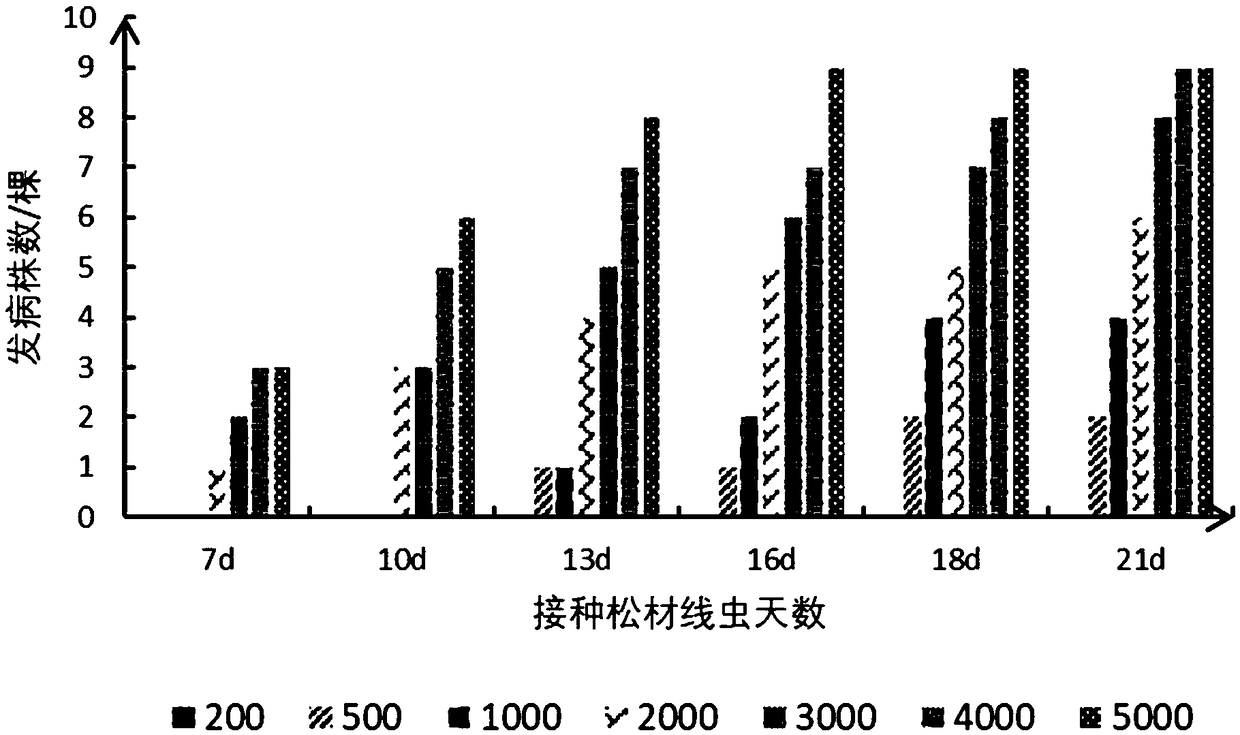Method for artificially inoculating pine wood nematodes by semiannual masson pine seedling tender tip skin scratch and application thereof
A technology of pine wood nematode and artificial inoculation, which is applied in the direction of animal husbandry and the like, can solve the problem of no masson pine seedlings inoculated with pine wood nematode, etc., and achieve the effects of improving inoculation efficiency, facilitating inoculation, and saving cultivation costs.
- Summary
- Abstract
- Description
- Claims
- Application Information
AI Technical Summary
Problems solved by technology
Method used
Image
Examples
Embodiment 1
[0041] Example 1 Inoculation of young shoot epidermis inoculation with pine wood nematodes
[0042] (1) adopt conventional method, a large number of live pine wood nematodes are cultivated;
[0043] (2) prepare the suspension of live pine wood nematode, concentration is 3000 / 200 microliters;
[0044] (3) Select 16 half-year-old masson pine seedlings with better growth, among which 10 strains are inoculated with 3000 pine wood nematodes, and 6 strains are used as blank controls to inoculate double distilled water. For the young shoots at about 3-5cm, pull down the needles 1.5-2cm;
[0045] (4) Use a sharp scalpel to draw two longitudinal wounds about 1.5 cm in length on the loose and tender epidermis where the needles have been removed, with a depth of 0.5 to 1 mm;
[0046] (5) Use a sealing film to form a small funnel around the part where the needles are removed. The diameter of the upper opening of the funnel is about 1.5cm to ensure that there will be no water leakage. Note...
Embodiment 2
[0054] Pine xylophilus inoculation of different concentrations of embodiment 2 semi-annual Pinus massoniana
[0055] According to the method of Example 1, different concentrations of B. xylophilus were inoculated. The difference from Example 1 was that the number of B. xylophilus inoculated was 200, 500, 1000, 2000, 3000, 4000, and 5000, totaling 7 treatments. Each treatment was repeated 10 times, and 6 Pinus massoniana seedlings inoculated with sterile water were used as controls. Observe the symptoms after inoculation, and count the total number of diseased strains 7, 10, 13, 16, 18, and 21 days after inoculation.
[0056] The result is as figure 2 As shown, the research results show that 7 days after inoculation, pine seedlings inoculated with 2000, 3000, 4000 and 5000 pine wood nematodes began to develop disease; The plants began to fall ill; the plants inoculated with 200 pine xylophilus plants did not suffer from the disease. As the number of days of inoculation incr...
Embodiment 3
[0057] Example 3 Observation on the Symptom Development Process of Pine Xylophilus Disease of Highly Susceptible Pinus massoniana
[0058] Once the half-year-old Pinus massoniana develops disease, it may die later due to its low resistance. Therefore, it can be designated as a high-resistant Pinus massoniana plant (no disease) or a resistant Pinus massoniana plant (slow disease onset) according to the time of onset and death. ) and high-sensitivity Masson pine plants (fast onset); specifically: high-sensitivity Masson pine does not develop disease; resistant plants generally inoculate for more than 10 days, or even longer to start to develop symptoms, and will die after 6-10 days or even longer after symptoms appear ; High-susceptibility plants generally begin to develop symptoms 8 to 10 days after inoculation, and most of them die after 3 to 5 days of symptoms.
[0059] According to the method of embodiment 1, adopt young shoot epidermis scratching inoculation method to 67 ha...
PUM
| Property | Measurement | Unit |
|---|---|---|
| Depth | aaaaa | aaaaa |
| Upper mouth diameter | aaaaa | aaaaa |
Abstract
Description
Claims
Application Information
 Login to View More
Login to View More - R&D
- Intellectual Property
- Life Sciences
- Materials
- Tech Scout
- Unparalleled Data Quality
- Higher Quality Content
- 60% Fewer Hallucinations
Browse by: Latest US Patents, China's latest patents, Technical Efficacy Thesaurus, Application Domain, Technology Topic, Popular Technical Reports.
© 2025 PatSnap. All rights reserved.Legal|Privacy policy|Modern Slavery Act Transparency Statement|Sitemap|About US| Contact US: help@patsnap.com



